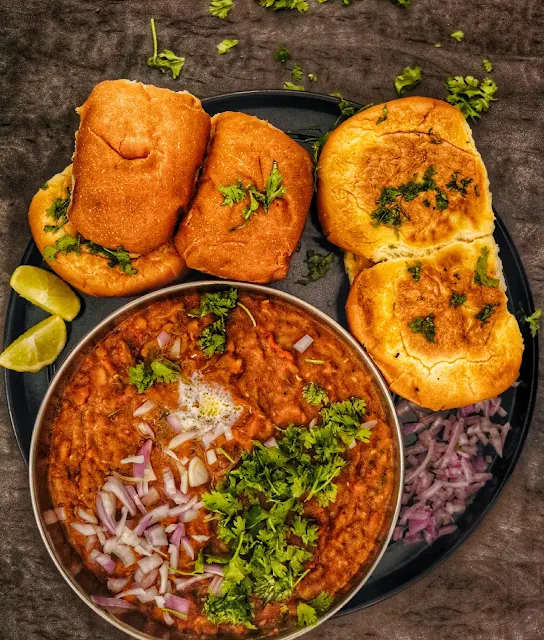Authentic Pav Bhaji Recipe: Discover Mumbai’s Ultimate Street Food Delight
Learn how to make authentic pav bhaji at home with our detailed recipe. Explore the history, ingredients, and step-by-step instructions behind Mumbai’s iconic street food.
Introduction
Pav bhaji isn’t just a dish—it’s an experience that encapsulates the vibrant essence of Mumbai’s street food culture. Originally conceived as a hearty meal for mill workers in the 1960s, pav bhaji has evolved into a culinary icon celebrated for its rich flavors and comforting warmth. With search data revealing high interest in terms such as “authentic pav bhaji recipe” and “how to make pav bhaji at home,” this guide will walk you through everything you need to know to master this classic dish.
The History and Cultural Significance of Pav Bhaji
Pav bhaji has its roots in the bustling streets of Mumbai, where innovative vendors transformed leftover vegetables into a delicious, nutrient-rich curry. Served with butter-toasted buns (pav), this dish quickly became a favorite among locals, symbolizing the city’s ingenuity and resilience. Today, pav bhaji is more than just a quick snack—it’s a cultural phenomenon that brings communities together over its bold, spicy flavors.
“authentic pav bhaji recipe”, “how to make pav bhaji at home”, “Mumbai street food pav bhaji”, “best pav bhaji recipe”, “homemade pav bhaji”
Ingredients for Authentic Pav Bhaji
 |
| Authentic Pav bhaji recipe Mumbai famous street food recipes |
For the Bhaji (Vegetable Curry)
- Mixed Vegetables: 3 cups (potatoes, cauliflower, green peas, carrots – boiled and mashed)
- Tomatoes: 4 large, finely chopped or pureed
- Onions: 2 medium, finely chopped
- Bell Pepper: 1, finely chopped
- Ginger-Garlic Paste: 1 tablespoon
- Green Chilies: 2, slit or finely chopped
- Pav Bhaji Masala: 2-3 tablespoons (store-bought or homemade blend)
- Red Chili Powder: 1 teaspoon (adjust to taste)
- Turmeric Powder: ½ teaspoon
- Butter: 4-5 tablespoons (divided)
- Salt: To taste
- Water: As needed to adjust consistency
- Fresh Cilantro: A handful, chopped
For the Pav (Buns)
- Pav Buns: 8-10 (if unavailable, soft dinner rolls work well)
- Butter: For toasting
Optional Garnishes
- Finely Chopped Onions
- Lemon Wedges
- Extra Butter or Cilantro
Step-by-Step Preparation
1. Prepare the Base of the Bhaji
- Sauté Onions: In a large, heavy-bottomed pan, melt 2 tablespoons of butter over medium heat. Add the finely chopped onions and sauté until they turn translucent.
- Add Aromatics: Stir in the ginger-garlic paste and green chilies. Cook for an additional minute until fragrant.
2. Incorporate Tomatoes and Spices
- Tomato Puree: Add the chopped or pureed tomatoes along with turmeric powder, red chili powder, and salt. Cook until the oil starts to separate from the tomato mixture.
- Pav Bhaji Masala: Sprinkle in the pav bhaji masala and mix well, allowing the spices to meld with the tomato base.
3. Add the Vegetables
- Combine Vegetables: Add the boiled and mashed vegetables (potatoes, cauliflower, carrots, and green peas) and chopped bell pepper. Stir thoroughly so that the vegetables blend with the tomato mixture.
- Adjust Consistency: Pour in a little water (about ½ cup to start) and let the bhaji simmer. Mash the mixture with the back of a ladle or potato masher to achieve a smooth, slightly chunky consistency. Add more water if necessary to reach your preferred thickness.
4. Simmer and Finalize
- Simmer: Allow the bhaji to simmer on low heat for 10-15 minutes. Stir occasionally to prevent sticking and to ensure that the flavors develop fully.
- Finish with Butter and Cilantro: Stir in the remaining butter and garnish with chopped cilantro. Taste and adjust salt or spices if needed.
5. Toast the Pav
- Butter Toast: Slice the pav buns horizontally. On a griddle or non-stick pan, melt a generous amount of butter and lightly toast the buns until they turn golden brown and slightly crisp on the edges.
6. Assemble and Serve
- Plate the Dish: Serve a hearty ladle of pav bhaji on a plate. Place 2-3 toasted pav buns on the side.
- Garnish: Offer finely chopped onions and a lemon wedge on the side so that diners can customize their flavor with a squeeze of lemon and an extra crunch.
Expert Tips for the Perfect Pav Bhaji
- Balance the Flavors: The secret to great pav bhaji lies in balancing tangy, spicy, and buttery flavors. Adjust the lemon and butter to suit your taste.
- Mashing Technique: For a smoother texture, mash the vegetables well while simmering. Use a potato masher and keep stirring.
- Slow Cooking: Allow the bhaji to simmer on low heat to let the flavors fully develop.
- Toasting is Key: Properly toasted pav with a slight crunch enhances the overall experience. Use enough butter and toast until golden.
Nutritional and Cultural Insights
Pav bhaji is not only a burst of flavors but also a wholesome dish rich in vegetables and spices. Although indulgent, it can be balanced with a side salad or a cup of masala chai. Its evolution from a humble, economical meal for laborers to a celebrated street food reflects Mumbai’s dynamic cultural landscape—a blend of tradition and innovation.
Conclusion
This authentic pav bhaji recipe offers a taste of Mumbai’s rich culinary heritage. By following this detailed guide, you can recreate this iconic dish at home, embracing the spirit of Mumbai’s vibrant street food culture. “authentic pav bhaji recipe” and “how to make pav bhaji at home,” .

Comments
Post a Comment